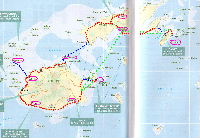Why Fiji? During our trip to New Zealand we had a stop over here. The idea to come back took up at once in me. So we sought out our tickets in the internet and bought the Lonely Planet Guide. We also booked the first three nights at the Wayalailai Resort on the island of Wayasewa.
We reached Nadi Airport (pronounced "Nandi") after a 22-hour flight via Seoul on Feb. 27th 2004. At the airport we were welcomed by a small band playing folk songs. Then we went on to the launch site in Lautoka were we took a boat to our final destination Wayasewa Island.
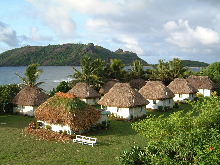 Waya Lailai Resort is owned and operated by the island inhabitants. Guests stay at rustical huts, the meals are taken together with the other guests. There are several activities as trekking and scuba diving. On Sunday we went to church. Women sat on one side, men on the other and children in the front. There was a lot of singing and it was a wonderful experience to witness the mass. The priest, that came from the mainland and stayed overnight, held a long preaching and welcomed us in English. On special occasions men wear skirts instead of trousers.
Waya Lailai Resort is owned and operated by the island inhabitants. Guests stay at rustical huts, the meals are taken together with the other guests. There are several activities as trekking and scuba diving. On Sunday we went to church. Women sat on one side, men on the other and children in the front. There was a lot of singing and it was a wonderful experience to witness the mass. The priest, that came from the mainland and stayed overnight, held a long preaching and welcomed us in English. On special occasions men wear skirts instead of trousers.
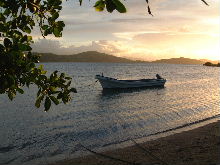 After three days of relaxing and after rats had nibbed at our cookies in our bags we went back to the main island Viti Levu and rode the bus to Rakiraki where we went on by boat to the islet of Nananu-i-Ra. There we stayed two days at McDonald's Resort. We had a little Bungalow with all amenities such as a kitchenette. We ate at the restaurant in the open in the evenings while enjoying the fresh breeze under the palm trees and admiring the star-dotted sky. During the day we went snorkeling to the coral reef in the open sea.
After three days of relaxing and after rats had nibbed at our cookies in our bags we went back to the main island Viti Levu and rode the bus to Rakiraki where we went on by boat to the islet of Nananu-i-Ra. There we stayed two days at McDonald's Resort. We had a little Bungalow with all amenities such as a kitchenette. We ate at the restaurant in the open in the evenings while enjoying the fresh breeze under the palm trees and admiring the star-dotted sky. During the day we went snorkeling to the coral reef in the open sea.
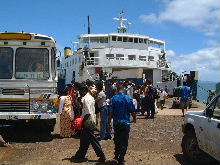 Our little paradise island was beautiful but we weren't just for the beach there and wanted to get to know the country. In Fiji there are two ethnic groups. The native people are Melanesians who are not unlike black Africans. Their social structure is strongly oriented to the community, their lifestyle rather easy-going. So nobody cared when the bus driver stopped at the supermarket to get something to drink while everybody else waited patiently in the bus. They are very friendly people who always greeted us with "bula" and never stopped smiling. They are christians. The Indians were brought by the British to work the cane fields. They dominate the trade. As hindus they are shy and introverted. They live mainly in the cities and are not allowed to attain land outside them as it is reserved for the natives.
Our little paradise island was beautiful but we weren't just for the beach there and wanted to get to know the country. In Fiji there are two ethnic groups. The native people are Melanesians who are not unlike black Africans. Their social structure is strongly oriented to the community, their lifestyle rather easy-going. So nobody cared when the bus driver stopped at the supermarket to get something to drink while everybody else waited patiently in the bus. They are very friendly people who always greeted us with "bula" and never stopped smiling. They are christians. The Indians were brought by the British to work the cane fields. They dominate the trade. As hindus they are shy and introverted. They live mainly in the cities and are not allowed to attain land outside them as it is reserved for the natives.
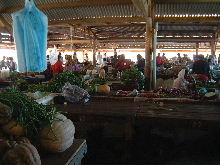 So we went on with the ferry to the second largest island, Vanua Levu. This island is much less developed than the main island Viti Levu. Here there is still a lot of nature and few tourists. From the port of Nabouwalu we rode the bus to the island capital of Labasa (pronounced "Lambasa") where one must not stay for very long. The next day we went on to Savusavu. During the trip the bus stopped at a creek with a waterfall where many filled up their water bottles. It rains a lot and the rivers are not polluted. Then we arrived at Savusavu and changed busses.
So we went on with the ferry to the second largest island, Vanua Levu. This island is much less developed than the main island Viti Levu. Here there is still a lot of nature and few tourists. From the port of Nabouwalu we rode the bus to the island capital of Labasa (pronounced "Lambasa") where one must not stay for very long. The next day we went on to Savusavu. During the trip the bus stopped at a creek with a waterfall where many filled up their water bottles. It rains a lot and the rivers are not polluted. Then we arrived at Savusavu and changed busses.
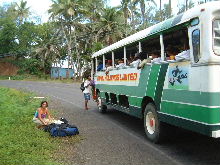 After a few kilometers we reached our next stay, Mumu's Resort, a small isolated hotel. It is a birdwatchers' paradise. Laisa cooked Fijian for us in the evening: Fried taro (a starch containing root), Indian lentil soup, vegetarian rice curry, cucumbers with pineapple pieces and as dessert fried starch banana with icecubes. Everyting was served on a table in the open air with a view of the sea and candlelight. It was just wonderful, we were alone. Laisa came to us and told us stories.
After a few kilometers we reached our next stay, Mumu's Resort, a small isolated hotel. It is a birdwatchers' paradise. Laisa cooked Fijian for us in the evening: Fried taro (a starch containing root), Indian lentil soup, vegetarian rice curry, cucumbers with pineapple pieces and as dessert fried starch banana with icecubes. Everyting was served on a table in the open air with a view of the sea and candlelight. It was just wonderful, we were alone. Laisa came to us and told us stories.
The next day started well but didn't end quite. After a very good breakfast on our terrace with a view of the far away island of Koro we visited Savusavu. There I felt the first symptoms of my cold. Back at the hotel I went to bed under the mosquito net with fever, where I stayed for the next day. That was a pitty as I very much would have liked to go snorkeling in the nearby beach. Laisa cooked wonderfully for us and brought the food through the rain to our room but I could not eat.
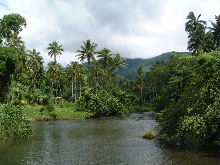 We went on, first by bus to the port of Natuvu and then by ferry to Waiyomo on the island of Taveuni. This island is still untouched. There are a lot of endemic bird species and a national park which we visited. There one can swim under a waterfall, very refreshing in the tropical heat. The landscape is beautiful but trekking is a sweating and demanding matter. During our walks we could admire the local big spiders. The female is conspicously big while the male can be barely seen. From our balcony in the hotel we could watch females wading through the shallow water of the sea, picking urchins which were later smoked in an open fire.
We went on, first by bus to the port of Natuvu and then by ferry to Waiyomo on the island of Taveuni. This island is still untouched. There are a lot of endemic bird species and a national park which we visited. There one can swim under a waterfall, very refreshing in the tropical heat. The landscape is beautiful but trekking is a sweating and demanding matter. During our walks we could admire the local big spiders. The female is conspicously big while the male can be barely seen. From our balcony in the hotel we could watch females wading through the shallow water of the sea, picking urchins which were later smoked in an open fire.
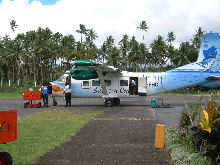 We liked Taveuni a lot but we had to go on. As a ferry trip would have lasted for days, we booked a flight from Matei to Ovalau. First we flew to Suva, Fiji's capital on the main island of Viti Levu, via Savusavu. We had to wait for five hours at the airport before our next 10-minute flight to Ovalau. The plane was the same but had meanwhile come back from another flight. We arrived in Ovalau and went on in a short trip by bus to Levuka, Fiji's former capital. There we stayed at the Royal Hotel in an atmosphere of British colonialism.
We liked Taveuni a lot but we had to go on. As a ferry trip would have lasted for days, we booked a flight from Matei to Ovalau. First we flew to Suva, Fiji's capital on the main island of Viti Levu, via Savusavu. We had to wait for five hours at the airport before our next 10-minute flight to Ovalau. The plane was the same but had meanwhile come back from another flight. We arrived in Ovalau and went on in a short trip by bus to Levuka, Fiji's former capital. There we stayed at the Royal Hotel in an atmosphere of British colonialism.
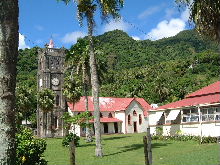 Levuka is a sleepy town which lives off a fish canning factory. There was not much to do and we enjoyed our stay a lot. It was sunday and time for playing rugby, the national sport of all former British colonies. The few stores on the main street are owned by Indians. On the evenings people sit there to watch and be seen, gossiping. Fijians are never in a hurry and always friendly. Natives always go on sundays to church.
Levuka is a sleepy town which lives off a fish canning factory. There was not much to do and we enjoyed our stay a lot. It was sunday and time for playing rugby, the national sport of all former British colonies. The few stores on the main street are owned by Indians. On the evenings people sit there to watch and be seen, gossiping. Fijians are never in a hurry and always friendly. Natives always go on sundays to church.
But after a few days it was too much calm for us and we went on with the ferry back to the main island of Viti Levu. Once there we took a bus to the capital city of Suva. After many days of wonderful, mainly Indian cuisine, I was ready for something meaty. So we went eating hamburgers. Suva is a small city. The parliamentary buildings and the president's residence are worth sighting.
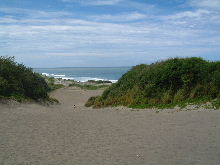 Then we went on to Sigatoka, where we visited the national park with the sand dunes. It was very hot and the trekking tiring but worthwhile. Here the realtively big Sigatoka River (pronounced "Singatoka") flows into the sea. It carries sediments that cause a turbidity in the water so that corals cannot grow. This means that waves break on the beach, carrying sand that builds up as dunes. In the evening we could admire a beautiful rainbow over the river at the hotel.
Then we went on to Sigatoka, where we visited the national park with the sand dunes. It was very hot and the trekking tiring but worthwhile. Here the realtively big Sigatoka River (pronounced "Singatoka") flows into the sea. It carries sediments that cause a turbidity in the water so that corals cannot grow. This means that waves break on the beach, carrying sand that builds up as dunes. In the evening we could admire a beautiful rainbow over the river at the hotel.
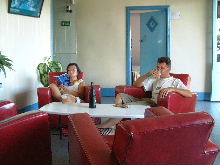 In the end we went back to Lautoka via Nadi, where we spent our last night in Fiji. We strolled for a last time through the city with its mosque and hindu temple. Many of the buildings are art-deco like in Miami Beach but not quite es famous.
In the end we went back to Lautoka via Nadi, where we spent our last night in Fiji. We strolled for a last time through the city with its mosque and hindu temple. Many of the buildings are art-deco like in Miami Beach but not quite es famous.
One must not go all the way to Fiji to have nice beaches. But, if you are interested in foreign cultures then you will be excited by Fiji's multitude facets and the friendliness of its people. And back in Germany there lingered an air of exotic in the souvenir of such a beautiful vacation.
Hermann Luyken
Ludwigshafen, 6.8.2005
|
